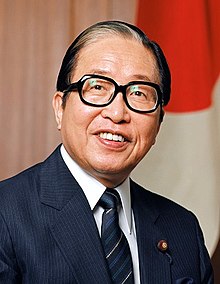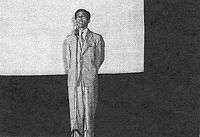Sōsuke Uno
Sōsuke Uno (宇野 宗佑, Uno Sōsuke, 27 August 1922 – 19 May 1998) was a Japanese politician who was briefly Prime Minister of Japan in 1989. A scandal exposed by the geisha Mitsuko Nakanishi contributed to his premature resignation from office after just sixty-eight days.
Sōsuke Uno | |
|---|---|
宇 野 宗 佑 | |
 Sōsuke Uno | |
| Prime Minister of Japan | |
| In office 3 June 1989 – 10 August 1989 | |
| Monarch | Akihito |
| Preceded by | Noboru Takeshita |
| Succeeded by | Toshiki Kaifu |
| Minister for Foreign Affairs | |
| In office 8 November 1987 – 3 June 1989 | |
| Prime Minister | Noboru Takeshita |
| Preceded by | Tadashi Kuranari |
| Succeeded by | Hiroshi Mitsuzuka |
| Minister of International Trade and Industry | |
| In office 10 June 1983 – 27 November 1983 | |
| Prime Minister | Yasuhiro Nakasone |
| Preceded by | Sadanori Yamanaka |
| Succeeded by | Hikosaburo Okonogi |
| Director General of the Administrative Management Agency | |
| In office 9 November 1979 – 17 July 1980 | |
| Prime Minister | Masayoshi Ōhira |
| Preceded by | Motohiko Kanai |
| Succeeded by | Yasuhiro Nakasone |
| Director General of the Science and Technology Agency | |
| In office 24 December 1976 – 28 November 1977 | |
| Prime Minister | Takeo Fukuda |
| Preceded by | Masao Maeda |
| Succeeded by | Tasaburo Kumagai |
| Director-General of the Japan Defense Agency | |
| In office 11 November 1974 – 9 December 1974 | |
| Prime Minister | Kakuei Tanaka |
| Preceded by | Sadanori Yamanaka |
| Succeeded by | Michita Sakata |
| Member of the House of Representatives | |
| In office 20 November 1960 – 20 October 1996 | |
| Personal details | |
| Born | 27 August 1922 Moriyama, Shiga, Empire of Japan |
| Died | 19 May 1998 (aged 75) Moriyama, Shiga, Japan |
| Political party | Liberal Democratic Party |
| Alma mater | Kobe University of Commerce |
| Signature |  |
| Military career | |
| Allegiance | |
| Service/ | |
| Years of service | 1943-1945 |
| Rank | Second Lieutenant |
| Battles/wars | Second World War
|
Early years

Sōsuke Uno was born in Moriyama, Shiga, the son of a successful brewer. He attended the Kobe University of Commerce after serving as an officer in the Imperial Japanese Army during World War II. As well as a politician Sōsuke was an accomplished writer, who wrote a book considered classic in Japan about his experiences as a prisoner of war in Siberia.
Political career
_(2).jpg)
In 1960 he entered politics, winning election to the Diet of Japan. Six years later he was promoted to Vice-Minister at the Ministry of International Trade and Industry, then similar positions with the Science and Technology Agency, then the Administrative Agency until earning his place in Cabinet as Minister for Trade and Industry and then Foreign Secretary until he was Prime Minister. Whilst Foreign Secretary (in what were conflicted times) he was applauded for his tact as foreign secretary, navigating international demands for increased Japanese contributions to international commerce with stern loyalty to his own nation's interests.
In 1974 he served briefly as Director General of the Japan Defense Agency.
Uno's career reached a peak in the most fraught times his party had seen, as he took the reigns of his party after the Recruit Scandal, when 47 Japanese MPs (including mostly other members from his own Liberal Democrat Party) were found guilty of taking bribes and unfair trading. Of all prime-ministerial candidates, only Uno was free of blame from them, and he was given charge over the party, the government, and Japan. By this stage he had served his country for almost fifty years, and was placed in office on 3 June 1989.
Geisha affair

Uno encountered public scandal in 1989, when accused by the geisha Mitsuko Nakanishi[1][2] of being "immoral" and stingy in his financial support during their four-month affair in 1986. Nakanishi would claim in following newspaper interviews that Uno had treated older geisha with arrogance and contempt, had not paid the appropriate fee of ¥300,000 per month (roughly US$21,000 at the time) for her company of four months, and had not provided a traditional parting gift (a further monetary fee) as had been custom in geisha etiquette.
A Washington Post article published in July 1989 brought international attention to the affair,[3] with some geisha denouncing Nakanishi as a whistleblower, effectively compromising the discreet nature of the profession and engaging with political and economic affairs in the public sphere. Nakanishi later quit the profession, re-married and divorced once, attended a Shingon Buddhist school temple in Shiga Prefecture, and held various jobs unrelated to the geisha community. Due to the severity of the scandal, Nakanishi's own son disowned her during this time.
To avoid further scandal, Sōsuke Uno resigned as prime minister in August 1989 after just 68 days in office, but continued to serve his country in various government posts until he retired fully in 1996. On 29 April 1994, he was awarded with the highest possible honour for a non-head-of-state, the Grand Cordon of the Order of the Rising Sun with Paulownia Flowers.[4]
Death
At 72 years of age, Sōsuke Uno then enjoyed a peaceful retirement in Moriyama city. He died in 1998 in his home. He published two collections of Haiku poems, as well as his book on prisonership in Siberia, along with painting, poetry, and music. A year later in 1999, his Geisha affair was highlighted in the Secret Life of Geisha, a TV documentary.[5]
Honours
- Grand Cordon of the Order of the Rising Sun with Paulownia Flowers - (29 April 1994)
References
- Carter, Paul. "Obituary: Sosuke Uno". independent.co.uk. The Independent. Retrieved 28 May 2020.
- Weisman, Steve R. (10 June 1989). "Ex-Geisha Accuses Uno Of a Dangerous Liason". nytimes.com. The New York Times. Retrieved 28 May 2020.
- Blustein, Paul (19 July 1989). "THE FEMINIST GEISHA". washingtonpost.com. The Washington Post. Retrieved 28 May 2020.
- https://www.britannica.com/biography/Uno-Sosuke
- https://www.imdb.com/title/tt0274282/
Further reading
- West, Mark D. (2006). Secrets, Sex, and Spectacle: The Rules of Scandal in Japan and the United States. Chicago University Press. ISBN 978-0-226-89408-9.
| Party political offices | ||
|---|---|---|
| Preceded by Noboru Takeshita |
Head of Youth Division, Liberal Democratic Party 1963–1966 |
Succeeded by Toshiki Kaifu |
| Preceded by Masumi Esaki |
Head of Diet Affairs Committee, Liberal Democratic Party 1974–1976 |
Succeeded by Toshiki Kaifu |
| Preceded by Noboru Takeshita |
President of the Liberal Democratic Party 1989 |
Succeeded by Toshiki Kaifu |
| Political offices | ||
| Preceded by Sadanori Yamanaka |
Director General of the Japan Defense Agency 1974 |
Succeeded by Michita Sakata |
| Preceded by Masao Maeda |
Director General of the Science and Technology Agency 1976–1977 |
Succeeded by Tasaburo Kumagai |
| Preceded by Motohiko Kanai |
Director General of the Administrative Management Agency 1979–1980 |
Succeeded by Yasuhiro Nakasone |
| Preceded by Sadanori Yamanaka |
Minister of International Trade and Industry 1983 |
Succeeded by Hikosaburo Okonogi |
| Preceded by Tadashi Kuranari |
Minister of Foreign Affairs 1987–1989 |
Succeeded by Hiroshi Mitsuzuka |
| Preceded by Noboru Takeshita |
Prime Minister of Japan 1989 |
Succeeded by Toshiki Kaifu |